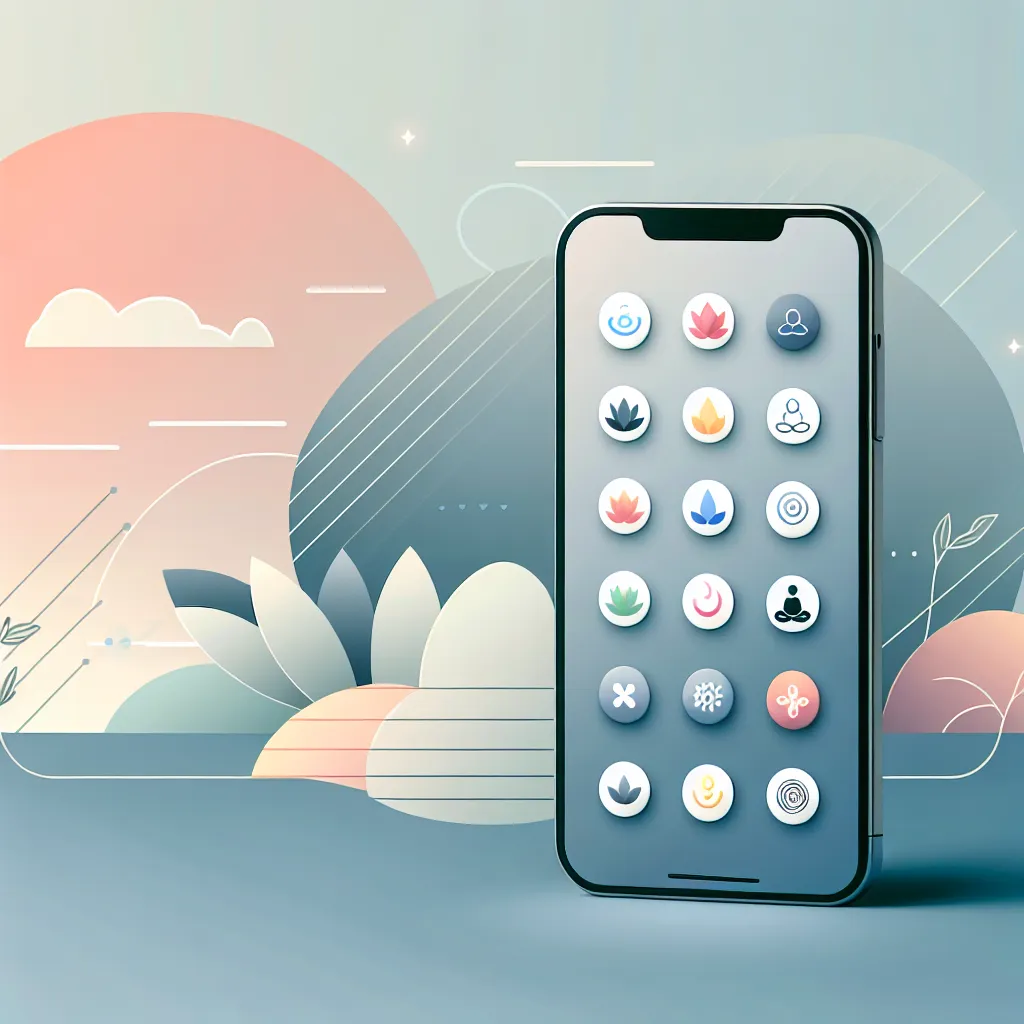The IELTS Reading section is a challenging component of the test, requiring candidates to demonstrate their English comprehension skills across various topics. Today, we’ll focus on a subject that has gained significant traction in recent years: mindfulness apps for anxiety. This topic has become increasingly relevant, especially in the context of mental health awareness and the growing popularity of digital wellness solutions.
Nội dung bài viết
Based on trends and past IELTS exams, there’s a strong possibility that a passage related to mental health technologies could appear in future tests. Let’s explore this theme through a practice reading exercise that mirrors the format and difficulty level of an actual IELTS exam.
 Mindfulness apps for anxiety on smartphone
Mindfulness apps for anxiety on smartphone
Reading Passage
Mindfulness in the Digital Age: Apps to Combat Anxiety
In an era where stress and anxiety have become prevalent issues, technology has stepped in to offer innovative solutions. Mindfulness apps have emerged as powerful tools to help individuals manage their mental health, particularly in dealing with anxiety. These digital aids provide accessible, user-friendly platforms for practicing mindfulness and meditation, bringing ancient techniques into the modern world.
The concept of mindfulness, rooted in Buddhist traditions, involves focusing one’s attention on the present moment. It has been scientifically proven to reduce stress, improve emotional regulation, and enhance overall well-being. As smartphones have become ubiquitous, developers have seized the opportunity to create apps that guide users through mindfulness exercises, making these practices more accessible than ever before.
Among the plethora of mindfulness apps available, several stand out for their effectiveness in combating anxiety. Headspace, one of the pioneers in this field, offers guided meditations and mindfulness exercises tailored for various situations, from work stress to sleep problems. Its user-friendly interface and science-backed approach have made it a favorite among beginners and experienced practitioners alike.
Another notable app is Calm, which has gained popularity for its soothing nature sounds and sleep stories narrated by celebrities. The app’s diverse content, including breathing exercises and body scans, caters to different needs and preferences. Users report significant improvements in their anxiety levels and sleep quality after regular use.
For those seeking a more personalized experience, Waking Up, created by neuroscientist Sam Harris, offers in-depth lessons on the theory and practice of meditation. The app combines guided meditations with lectures on consciousness and the nature of mind, appealing to those who want to understand the science behind mindfulness.
Insight Timer takes a different approach by offering a vast library of free meditations led by various teachers worldwide. This app stands out for its community features, allowing users to connect with others and participate in group meditations, fostering a sense of belonging and support.
While these apps have shown promising results, it’s important to note that they should not be considered a replacement for professional mental health care. However, they can serve as valuable complementary tools in managing anxiety and promoting overall mental well-being.
As technology continues to evolve, we can expect to see more sophisticated mindfulness apps incorporating features like artificial intelligence and virtual reality. These advancements promise to make mindfulness practices even more engaging and effective, potentially revolutionizing how we approach mental health in the digital age.
Questions
Multiple Choice
-
According to the passage, mindfulness apps:
A) Are a complete replacement for professional mental health care
B) Only work for experienced meditation practitioners
C) Provide accessible platforms for practicing mindfulness
D) Are ineffective in combating anxiety -
Which of the following is NOT mentioned as a feature of the Calm app?
A) Guided meditations
B) Celebrity-narrated sleep stories
C) Personalized mental health assessments
D) Breathing exercises -
The app Waking Up is described as:
A) Focusing primarily on sleep improvement
B) Offering in-depth lessons on meditation theory and practice
C) Having the largest library of free meditations
D) Being the most popular among beginners
True/False/Not Given
- Mindfulness practices originated from Buddhist traditions.
- All mindfulness apps mentioned in the passage require payment for full access.
- Scientific studies have proven that mindfulness can reduce stress levels.
- Headspace is the most widely used mindfulness app globally.
Matching Information
Match the following features with the correct app:
- Offers community features and group meditations
- Provides sleep stories narrated by famous people
- Created by a neuroscientist
- Known as one of the first popular mindfulness apps
A) Headspace
B) Calm
C) Waking Up
D) Insight Timer
Summary Completion
Complete the summary below using NO MORE THAN TWO WORDS from the passage for each answer.
Mindfulness apps have become popular tools for managing (12) and improving mental health. These apps bring (13) techniques into the digital age, making them more accessible. While each app has its unique features, they all aim to help users practice (14) and reduce stress. However, it’s important to note that these apps should be used as (15) tools and not as substitutes for professional mental health care.
Answer Key and Explanations
-
C
Explanation: The passage states that mindfulness apps “provide accessible, user-friendly platforms for practicing mindfulness and meditation.” -
C
Explanation: The passage mentions guided meditations, sleep stories, and breathing exercises for Calm, but does not mention personalized mental health assessments. -
B
Explanation: Waking Up is described as offering “in-depth lessons on the theory and practice of meditation.” -
True
Explanation: The passage states, “The concept of mindfulness, rooted in Buddhist traditions…” -
Not Given
Explanation: The passage doesn’t provide information about the payment requirements for all the apps mentioned. -
True
Explanation: The text mentions that mindfulness “has been scientifically proven to reduce stress.” -
Not Given
Explanation: While Headspace is described as a pioneer, the passage doesn’t state it’s the most widely used globally. -
D
-
B
-
C
-
A
-
anxiety
-
ancient
-
mindfulness
-
complementary
Common Mistakes
When tackling a reading passage like this, students often make the following mistakes:
-
Overlooking key phrases: Pay attention to phrases like “should not be considered a replacement” which are crucial for True/False/Not Given questions.
-
Misinterpreting “Not Given”: Remember, if the information isn’t explicitly stated in the passage, the answer is “Not Given,” even if it seems logical.
-
Rushing through the text: Take time to understand the context and relationships between ideas, especially for matching questions.
-
Ignoring word limits: In summary completion tasks, stick strictly to the word limit given.
Vocabulary
- Ubiquitous (adjective) /juːˈbɪkwɪtəs/ – present, appearing, or found everywhere
- Plethora (noun) /ˈpleθərə/ – a large or excessive amount of something
- Tailored (adjective) /ˈteɪləd/ – made or adapted for a particular purpose or person
- Pioneered (verb) /ˌpaɪəˈnɪəd/ – developed or introduced new ideas or methods
- Complementary (adjective) /ˌkɒmplɪˈmentəri/ – combining in such a way as to enhance or emphasize the qualities of each other or another
Grammar Focus
Pay attention to the use of present perfect tense in sentences like:
“Mindfulness apps have emerged as powerful tools…”
This tense is used to describe actions that started in the past and continue to be relevant in the present. The structure is:
Subject + have/has + past participle
For example:
- These apps have become popular among users of all ages.
- Developers have created various features to engage users.
Tips for High Scores in IELTS Reading
-
Time management is crucial. Allocate your time wisely across all sections of the reading test.
-
Skim the passage quickly first to get a general idea, then read more carefully when answering questions.
-
For multiple-choice questions, eliminate obviously incorrect options to increase your chances of selecting the right answer.
-
In True/False/Not Given questions, be careful not to bring in outside knowledge. Base your answers solely on the information provided in the passage.
-
For matching tasks, use the process of elimination and double-check your answers.
-
In summary completion tasks, pay close attention to word limits and grammatical fit.
-
Regularly practice with diverse reading materials to improve your speed and comprehension.
-
Expand your vocabulary by learning new words in context, which will help you understand complex passages more easily.
By following these tips and practicing regularly, you can improve your performance in the IELTS Reading section. Remember, consistency is key in preparing for the IELTS exam.
For more strategies on managing test anxiety, check out our article on tips for reducing anxiety during IELTS. Additionally, if you’re interested in exploring meditation further, you might find our guide on best apps for meditation helpful in your IELTS preparation journey.


